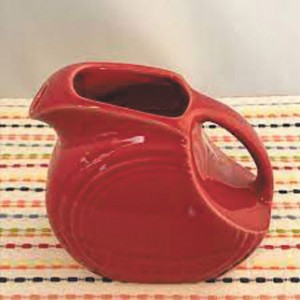Many have tried to capture the brilliance of Fiesta in words, but it It is perhaps best described in the 1936 magazine ad which read, “The new idea in American dinnerware . . . smart, sophisticated, and rich in color. It is the California fashion that has swept the nation.”
Fiestaware, developed by famous Stoke-on-Trent potter, Fredrick Rhead, was produced for over 30 years, from 1936-1972. It was originally issued with 36 different pieces including basic table service, divided plates, a coffee pot, carafe, candle holders, pitchers, 2 compotes, an ashtray, nappies, a set of 7 mixing bowls, and two covered serving dishes. The 1936 line featured five colors: cobalt blue, light green, yellow, ivory, and a bright orange color that is known as “Fiesta Red.” Turquoise, though often considered one of the original colors, was not introduced until the following year.
Ever aware of public opinion, Homer Laughlin was quick to drop pieces that did not meet with approval. The first piece to go was a twelve compartment plate that appeared only in the 1936 line. Next was the covered onion soup which ceased production in 1937. The tripod candle holder and the stick-handled demitasse coffeepot, and the 10” and 12” vases were all discontinued in 1942. These pieces are considered very rare and will demand top dollar. Although not discontinued from the line, several pieces including the sugar bowl, tea cups, utility trays, creamer, the nesting bowls and the ashtray were modified within the first few years of production.
Fiesta Kitchen Kraft was introduced in 1939. This instantly popular line included pie plates, refrigerator sets, mixing bowls, and covered jars in four popular Fiesta colors. Watch for these as they are very collectable.
In 1943 “Fiesta Red” was dropped from the line. Production of the red glaze required the use of uranium which was needed for the war effort. It would remain absent from the line until March of 1959. Even in the absence of their most popular color, sales boomed for Fiesta in the 1940s as they offered incredible deals such as their 7 piece juice set the retailed for only $1. The best year on record for Fiesta sales came in 1948 when they produced over 10 million pieces.
In 1951 a new line of colors was introduced. Cobalt, light green and ivory were retired, replaced with gray, rose, dark forest green and chartreuse. Pieces discontinued in the late 50s included the mustard and marmalade containers, the 8” vase, the footed salad bowl, relish tray, 11 1/2” fruit bowl, the candle holder, 10 oz. tumblers, the ice pitcher and the large tea pot. Red returned in 1959 and the eleventh Fiesta color, medium green, was introduced.
The 1960s marked the end of an era for Fiesta. Unlike previous decades when they had constantly revamped their pieces to suit the public’s ever-changing taste, the only alteration to the line was the discontinuance of the 6” dessert bowl in 1961. By 1969 sales had dropped drastically and they restyled the entire line and put out ironstone. The new line contained only 19 pieces and ran in production until 1973. The last two colors introduced were Antique Gold and Turf Green. Fiesta from 1969-1973 is of little interest to collectors.
Fiesta was reintroduced by Homer Laughlin in 1986 to celebrate it’s 50th anniversary. Colors for this issue were white, black, pink, apricot and cobalt blue. Although newer pieces are attractive and serviceable, it is the Vintage Fiesta from pre-1960 and Original Fiesta from the 1930s that is sought by collectors. Very early pieces were not marked. The ink stamp ‘GENUINE fiesta” (with the “Fiesta” in lower case), “Fiesta HLC USA” and ‘Fiesta MADE IN USA” were the earliest marks used. Until next time . . . Linda
Linda Kennett may be reached at 317-258-7835 or lkennett@indy.rr.com



